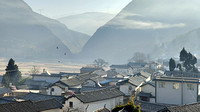Yunnan (literally "South of the Clouds") is a province of the People's Republic of China, located in the far southwest of the country spanning approximately 394,000 square kilometers (152,000 square miles). The capital of the province is Kunming. The province borders Myanmar (Burma), Laos, and Vietnam.
Yunnan is situated in a mountainous area, with high elevations in the northwest and low elevations in the southeast. Most of the population lives in the eastern part of the province. In the west, the relative height from mountain peaks to river valleys can be as much as 3,000 m. Yunnan is rich in natural resources and has the largest diversity of plant life in China. Of the approximately 30,000 species of higher plants in China, Yunnan has over 17,000. Yunnan's reserves of aluminium, lead, zinc and tin are the largest in China, and there are also major reserves of copper and nickel. Yunnan has over 600 rivers and lakes, which provide an annual water supply of 222 billion cubic meters. Projected hydropower reserves stand at 103 million KW, with an exploitable capacity of 90 million KW, capable of generating 349 KW of electricity annually.
Yunnan became part of the Han Dynasty (206 BC-220 AD) during 2nd century BC and became the seat of a Tibeto-Burman speaking kingdom known as Nanzhao in the 8th century. Nanzhao was multi-ethnic, but the elite most likely spoke a language close to Yi and modern Burmese. The Mongols conquered the region in the 13th century, with local control exercised by warlords until the 1930s. As with other parts of China's southwest, Japanese occupation in the north during World War II forced a migration of Chinese into the region. Ethnic minorities in Yunnan account for about 34 percent of its total population. Major ethnic groups include Yi, Bai, Hani, Zhuang, Dai and Miao. [Source: Wikipedia]
Yunnan is a colorful land dubbed the photographer's paradise. I've visited Yunnan twice (in 2006 and 2011), each trip 16 days long.
Yunnan is situated in a mountainous area, with high elevations in the northwest and low elevations in the southeast. Most of the population lives in the eastern part of the province. In the west, the relative height from mountain peaks to river valleys can be as much as 3,000 m. Yunnan is rich in natural resources and has the largest diversity of plant life in China. Of the approximately 30,000 species of higher plants in China, Yunnan has over 17,000. Yunnan's reserves of aluminium, lead, zinc and tin are the largest in China, and there are also major reserves of copper and nickel. Yunnan has over 600 rivers and lakes, which provide an annual water supply of 222 billion cubic meters. Projected hydropower reserves stand at 103 million KW, with an exploitable capacity of 90 million KW, capable of generating 349 KW of electricity annually.
Yunnan became part of the Han Dynasty (206 BC-220 AD) during 2nd century BC and became the seat of a Tibeto-Burman speaking kingdom known as Nanzhao in the 8th century. Nanzhao was multi-ethnic, but the elite most likely spoke a language close to Yi and modern Burmese. The Mongols conquered the region in the 13th century, with local control exercised by warlords until the 1930s. As with other parts of China's southwest, Japanese occupation in the north during World War II forced a migration of Chinese into the region. Ethnic minorities in Yunnan account for about 34 percent of its total population. Major ethnic groups include Yi, Bai, Hani, Zhuang, Dai and Miao. [Source: Wikipedia]
Yunnan is a colorful land dubbed the photographer's paradise. I've visited Yunnan twice (in 2006 and 2011), each trip 16 days long.
© Weng Photography














